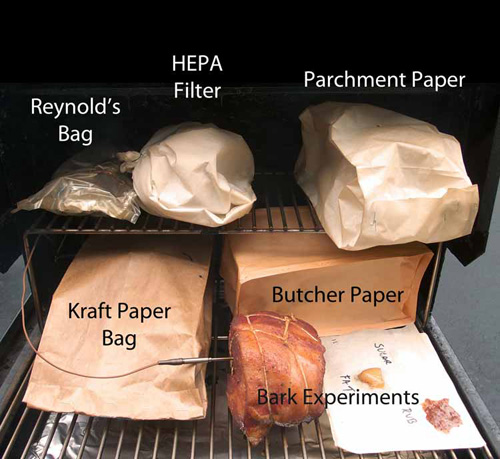| g e n u i n e i d e a s | ||||||
 |
 |
 |
 |
 |
 |
 |
| home | art and science |
writings | biography | food | inventions | search |
| the ghost in the smoke | ||
|
||
|
May 2014 Summary- are smoke particles important for smoking?
Smoke is visible. Smoke gets in your eyes. But smoke, those gritty particles of unburned wood mixed with creosote and ash, carry very little in the way of actual smoke FLAVOR. And won't produce a smoke ring no matter how dense the plume- you need invisible CO and NO gases for that. Smoke flavor is a misnomer. True, smoke particles contribute color and a slight acrid taste, but the real game is played out of sight. Most of the smoke flavor in barbecue arises from invisible molecules like syringol and guaiacol, that land on the meat via a condensation-and-flow process called "thermophoresis". And smoke particles are quite large- hundreds to thousands of times bigger than salt ions or a nitrite molecule, so they barely penetrate into the meat. This is why smoke color and some flavor is easily washed off in the Texas Crutch. How do we know smoke particles do not contribute flavor or color the ring? Well, scientists have installed electrostatic precipitators (like the air cleaner in your furnace to reduce allergens and dust) which scrub smoke of even the tiniest carbon mote. And the ring and flavor remained. In fact, commercial smokehouses routinely scrub particles out of the smoke to eliminate acrid flavors. But with "kitchen science", we can learn even more by smoking meat INSIDE filter paper. Here I placed pork tenderloins in five kinds of filter bags- parchment paper, a kraft paper bag, butcher paper, a Reynold's turkey basting bag, and a HEPA (high-efficiency particulate air) filter you might buy for your shopvac. All these papers are porous at the atomic level and will allow tiny molecules (perhaps consisting of a half dozen atoms) to pass. Others contain a tortuous network of larger channels, which will impede big complex molecules like creosote and completely block enormous smoke particles you see coming out of the chimney. Porosity varies by filter type. You can barely blow air through the kraft and butcher paper. The HEPA filter is air permeable, of course, while the parchment paper and oven bag are impermeable to air flow. But this does not mean that tiny atoms can't squeeze through. Only the parchment paper and Reynold's bags are food safe- the kraft and butcher paper (though often used by chefs) contains clays, dyes and adhesives (called "sizing") which dissolve out at high temperatures. And the HEPA filter is usually made from fiberglass felt. Not dangerous, but not safe either. The meat sat in aluminum foil trays under wire frames (like a camping tent) to prevent meat juices from touching the paper, being absorbed by the filter and clogging up the pores1. After cooking for six hours in a pellet smoker at 225F, I opened each bag. The insides were uncolored- none of the smoke particles or creosote droplets made it through.
But amazingly, the meat displayed a deep smoke ring and strong smoke flavor! Small molecules, such as CO and NO and many smoky polymers, snuck though the gaps in the paper. And landed on the meat. And all samples were all pretty tender for tenderloin (which is normally cooked to 150F), because humidity in the bag was higher than in the smoker. Not steaming like in the Texas Crutch (all the bags are water vapor permeable to some extent, except for the Reynolds)- but still humid.
The Reynold's bag is a dense plastic (probably nylon). Nylon is a long chain of molecules called a polymer, and this polymer is linked to adjacent chains, forming a dense film. But there are still tiny gaps between the chains large enough for CO and NO to slowly navigate. Only when the tenderloin was touching the film did it encounter the very small inward flow of these molecules- so the ring was thin and spotty. A "smoke screen" is a diversion in life or on the battle-field. It is also a diversion while cooking- all the magic of smoking happens out of sight.
|
||
|
1 Alternatively, if you want to increase humidity around the meat AND still absorb smoke flavor without constructing a wire frame, you can cook entirely in an aluminum foil tray with the top sealed off by a sheet of kraft or butcher paper. I attach the paper to the tray rim with either staples or thesis clips. Not quite as much smoke exposure, but good enough.
|
||
Contact Greg Blonder by email here - Modified Genuine Ideas, LLC. |

